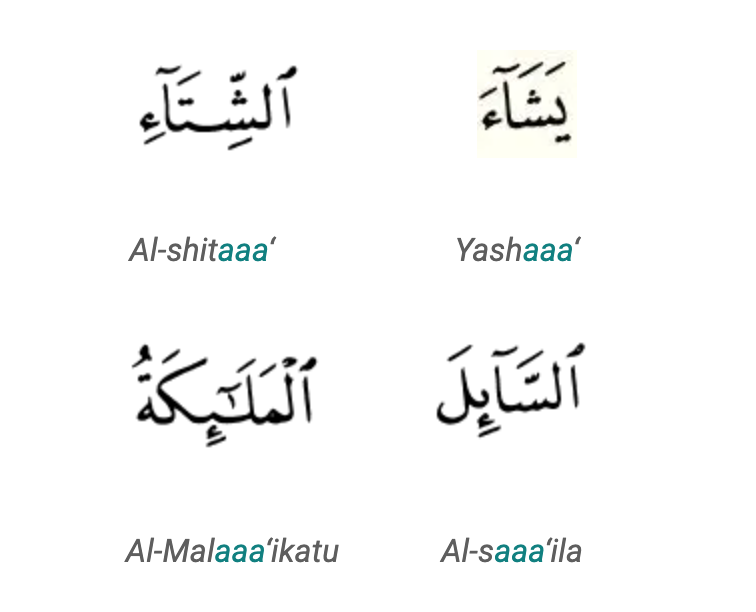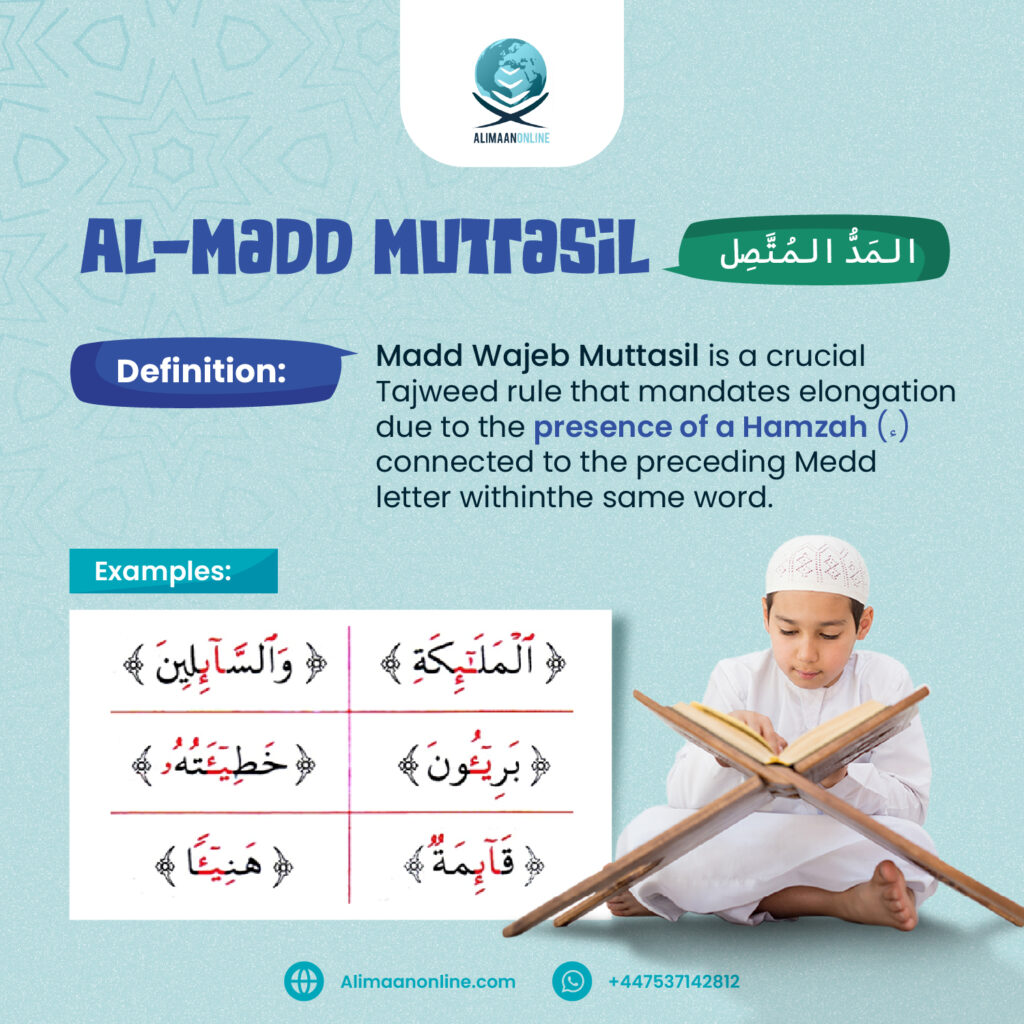Al Madd Al Muttasil, a fundamental aspect of Tajweed, holds immense significance in the Arabic language and Quranic recitation.
Al-Madd Muttasil المَدُّ المُتَّصِل
Madd Wajeb Muttasil, a crucial Tajweed rule, mandates elongation due to the presence of a Hamzah (ء) connected to the preceding letter within the same word. This rule dictates that the vowel sound preceding the Hamzah must be prolonged for a defined duration, typically lasting four to five beats or units of time. This rule serves to uphold the accurate pronunciation, rhythm, and flow of Quranic verses. It ensures clear pronunciation of the Hamzah and adherence to Tajweed principles.
The madd letters represent elongated vowels in Arabic. According to the rule, these letters should be pronounced for four to six harakat (counts or beats). This elongation is vital in Quranic recitation, influencing both the meaning and the musicality of the recited text.
Why Madd Al Muttasil is Considered Waajib in Tajweed
Preservation of Meaning: Arabic is a language rich in nuance, where slight pronunciation variations can alter meanings significantly. Madd Al Muttasil is mandated to maintain the exact meanings of Quranic words. By ensuring correct vowel elongation, reciters uphold the intended meanings of the verses.
Uniformity in Recitation: Madd Waajib, as a Waajib rule, establishes a standard for recitation. This consistency ensures that regardless of the reciter or location, the words and their meanings remain unchanged, preserving the Quran’s integrity.
Enhancing Recitation Quality: Islam emphasizes quality and beauty in recitation. The elongation of Madd Waajib adds a rhythmic and melodious quality, deepening the listener’s emotional and spiritual connection to the text.
Impact of Madd Al Muttasil on Meaning and Pronunciation
Clarity in Pronunciation: Madd Waajib emphasizes phonetic components, enhancing clarity in pronunciation. Each word becomes distinctly understood, reflecting the precision of Arabic.
Altering Meaning: Incorrect application or omission of Madd Waajib can change word meanings, leading to text misunderstandings. Precision is crucial, especially in religious texts believed to be divinely chosen.
Emotional and Spiritual Resonance: Vowel elongation influences the emotional tone of recitation. Madd Al Muttasil’s implementation contributes to the rhythm, deeply resonating with listeners and reciters, fostering a profound connection to the Quran’s spiritual essence.
The Rules of Madd Al Muttasil
Madd Waajib is a nuanced rule within Tajweed that regulates the elongation of certain vowels during Quranic recitation. To grasp its intricacies, we need to delve into how it occurs, the required duration of elongation, and glean examples from the Quran.
How Madd Al Muttasil Occurs?
Madd Waajib manifests when a madd letter (ا, و, or ي) directly precedes a hamza (ء) within the same word. These madd letters, serving as prolonged vowels in Arabic, naturally flow within the language. However, when followed by a hamza, their pronunciation undergoes elongation according to specific rules. This elongation isn’t arbitrary; rather, it’s governed by Tajweed principles, ensuring consistency and clarity in Quranic recitation.
Key Conditions for Madd Al Muttasil:
- Presence of a Madd Letter: The word must contain a madd letter, which includes ‘alif (ا)’, ‘waaw (و)’, and ‘yaa (ي)’.
- Followed by Hamza: The madd letter must be directly followed by a hamza within the same word.
- Elongation: The sound of the madd letter is stretched or prolonged during recitation.
Duration of Elongation in Madd Waajib:
The elongation for Madd Waajib typically lasts between four to six harakat (counts or beats). This duration isn’t a mere suggestion but a prescribed length to maintain uniformity and fidelity to the recitation style of the Prophet Muhammad.
- Four Harakat: Often considered the minimum length of elongation.
- Six Harakat: Reciters may extend up to six Harakat based on the context or the style of recitation.
Examples of Madd Al Muttasil in Quranic Verses
To illustrate the application of Madd Waajib, let’s examine examples from the Quran. These examples provide a visual representation of how the rule is applied in practice and its effect on word pronunciation.
Madd Muttasil appears in various places in the Quran. Below are some examples:

Identifying Madd Al Muttasil
Recognizing Al Madd Al Muttasil in words is crucial for students and practitioners of Tajweed. It involves understanding specific letter characteristics and Arabic word structures. This section guides you through identifying Madd Al Muttasil and understanding the role of Hamza’s representation.
How to Spot Madd Waajib in Words
To identify Madd Al Muttasil, look for two main components: a Madd letter and its subsequent hamza within the same word. Follow these steps:
1. Look for a Madd Letter: Identify Alif (ا), Waw (و), or Yaa (ي) in the word, indicating potential elongation.
2. Check for Subsequent Hamza: Ensure the madd letter is immediately followed by a hamza (ء) within the word. The hamza must be within the same word to qualify.
3. Contextual Reading: Understand the sentence structure to spot Madd Waajib accurately, as pronunciation may vary based on context.
By practicing these steps, readers can become adept at identifying Madd Waajib in different contexts and words.
The Difference in Hamza’s Representation and its Role
Hamza’s representation significantly affects Madd Al Muttasil’s identification and pronunciation:
1. Hamza with Harakah: When accompanied by a short vowel sign (harakah) like fatha (َ), damma (ُ), or kasra (ِ), hamza following a madd letter indicates Madd Waajib.
2. Hamza without Harakah: Even without a harakah or in standalone form (ء), hamza following a madd letter within the same word signifies Madd Waajib.
3. Different Forms of Hamza: Hamza can appear at the beginning, middle, or end of a word (e.g., أ, إ, ئ, ؤ), affecting pronunciation. Understanding these forms aids in identifying Madd Waajib accurately.
Recognizing hamza’s variations and its combination with madd letters is essential for correctly identifying and pronouncing Madd Waajib. Continuous practice enhances proficiency in applying this rule effectively.
The Importance of Madd Waajib
It transcends being a mere recitation rule; it’s a cornerstone that profoundly influences the clarity, meaning, and beauty of Quranic recitation. Understanding its significance involves exploring why Tajweed deems it mandatory (Waajib) and how it shapes the pronunciation and meaning of Quranic words.

